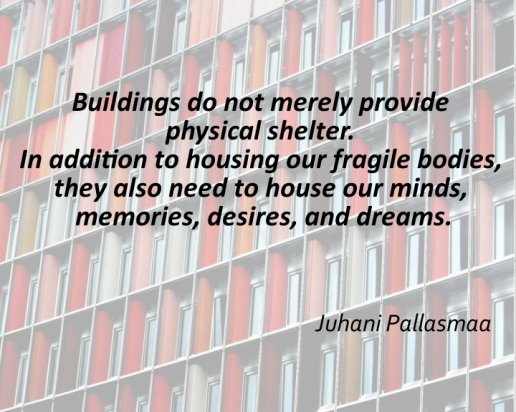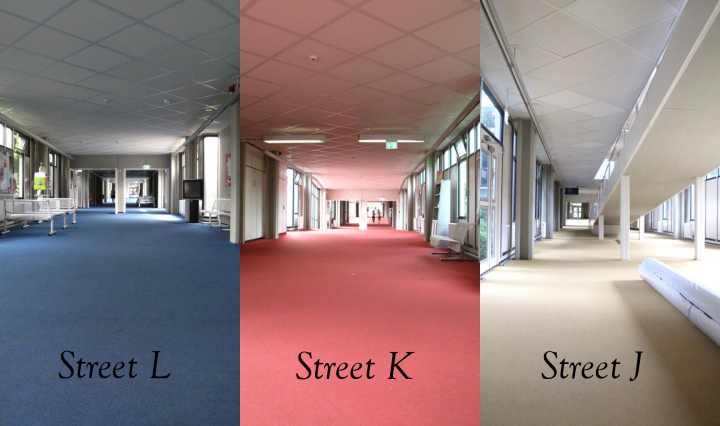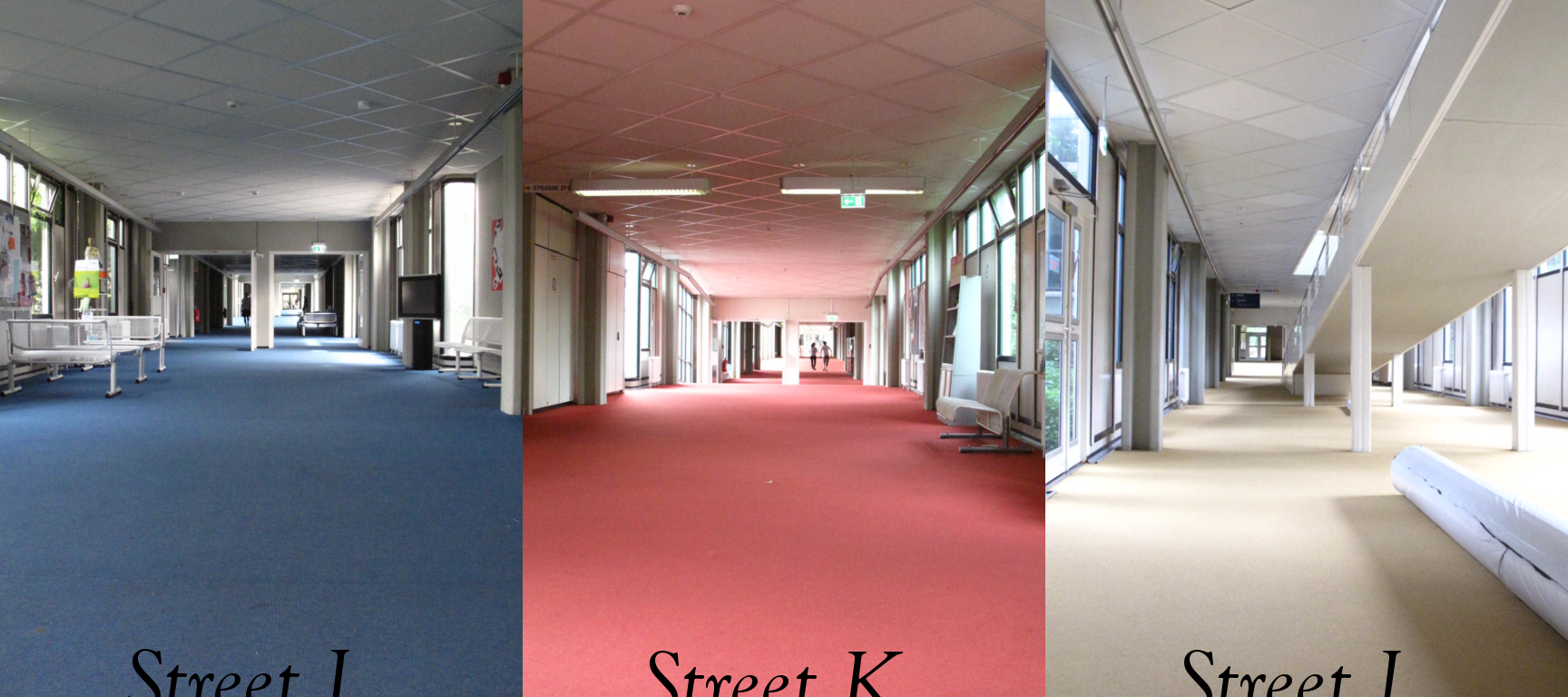
In developed countries, people spend around 90% of their time in enclosed spaces.[1] Have you ever thought about how much time you spend indoors and how the design of those places influences your behavior, well-being, and productivity? Can classroom design influence learning? Are you more productive in a shared or private environment? Would you like your house to assist you in your daily activities such as cleaning and cooking?
It’s about time we turned our attention to architecture – a ubiquitous phenomenon that influences our lives on a daily basis. Whereas this concept comprises both exterior and interior design we will mainly focus on the latter in this post.
Embodied Account of Architecture
If you still think that people are detached observers who perceive architectural spaces as just a set of physical properties, I am sorry to disappoint you, but this view is out of fashion. The current approach emphasizes the connection between a building and a person who experiences it. According to the embodied account, our perception, thoughts, and emotions are dependent on and shaped by the interaction with the environment. In other words, we are not merely passive recipients of sensory information, but we actively construct our experience of the architectural space through interacting with it.[2] To paraphrase architect Juhani Pallasmaa, we experience ourselves in the environment, and the environment exists through our embodied experience.[3]
Perceiving Space through Action: Embodied Simulation
Let’s take a look at the mechanisms that are likely to underlie our embodied experiences.
Embodied simulation is an important concept for understanding the perception of space. Seeing a manipulable object leads to the simulation of a grasping action. Seeing someone else performing an action or experiencing a sensation (e.g. touch) or a certain emotion, activates our brain as if we were doing or experiencing the same. Embodied simulation can be thought of as our means of connecting to the world around us. And perception of space and objects around us can be conceptualized as mapping these spaces and objects on potential action schemata.[4]
At the core of embodied simulation lies the activity of the so called canonical and mirror neurons. The former are active both when the monkey grasps an object and when it sees an object that can be grasped, while the latter react to performing an action as well as to observing the same or related kind of action.[4] A meta-analysis of 125 human neuroimaging studies showed that neurons with mirror properties can be found in the human brain in areas associated with action execution and observation, processing of somatosensory information, as well as affect-related areas.[5]
Experiencing Architecture
Though better controlled experiments are needed, some neuroimaging studies have already looked at how people experience specific aspects of space. Rooms with curved lines, high ceilings, and open rooms were perceived as more beautiful. Since curvilinear spaces were also judged more pleasant and activated the area implicated in emotional processing, it is possible that the preference for curved contours is grounded in affect.[6], [7]
So far, research has mostly concentrated on the visual domain. But this is not to say that we can disregard other modalities. In fact, acoustic, olfactory, and tactile sensations are an integral part of how we experience space.[3] Exotic scents in a spa help to create relaxing atmosphere. A frieze carpet produces the sense of coziness and shelter, while a sleek stone floor lets you know you’re in an official and solemn place. Sound is a very efficient instrument for creating a shared group experience,[3] so no wonder that acoustics has been particularly important in temple architecture. A curious example is El Castillo pyramid of Chichen Itza, whose stairs were designed to make footsteps resemble the sound of raindrops, thus physically incorporating the rain theme – very important in Mayan culture – into the worshiping experience.[8]

What’s in It for Us?
Awareness of the effects of architectural design can help us make our surroundings more attuned to our needs. For example, nature views reduce attention fatigue and could thus increase productivity.[9] Presence of decorative objects, such as plants or magazine racks could improve mood, compared to being in a bare room.[10] Academic success is influenced by light, wall color, and spatial configuration of the classroom.[11] While open offices help reduce space costs, they can evoke feelings of privacy threat, intensify workload, and lower job satisfaction.[12]
Much research is being done on how to design spaces better suited to social groups with special needs. As dementia progresses spatial orientation abilities deteriorate, and nursing homes can employ designs that facilitate wayfinding.[13] Furthermore, adjusting the lighting in the nursing homes could decrease nocturnal restlessness in dementia patients.[14] Hospitals can be made more comforting and less fear evoking by using home-like design, elements that divert attention from the medical nature of the building, and maximizing control over the immediate environment of the patient.[15] Creating housing that takes into account the influence of various design elements on well-being and social interactions could encourage the re-integration of prisoners into the community and possibly lower the recidivism rates.[16]
Smart Design: Neuromorphic Architecture
Though most of our homes are probably still not very tech savvy – the greatest achievement being air conditioning – the era of smart design has already begun. Smart design emphasizes the ability of the space to recognize the needs of its inhabitants and make the environment better suited to those needs, as well as meet the sustainable criteria. As an example, consider buildings that monitor and automatically adjust light or temperature depending on the time of day or temperature outside. These processes are based on the use of sensors, actuators and computational algorithms.[17]
Michael Arbib, neuroscientist and Professor at the University of Southern California, set out to develop the field of smart architectural design even further with the help of neuroscience. According to his neuromorphic architecture approach, buildings can be viewed as possessing a kind of a brain in analogy to living organisms that he calls “interactive infrastructure”. Our knowledge about the functioning of the brain could help us create such interactive infrastructures that would enable a room to interact with people inside it and other rooms in the building, so that the architectural space can change and adapt to better recognize and serve the needs of its inhabitants. Imagine a kitchen that could recognize the recipe that you’re cooking and hand you out the ingredients automatically! [17]
Critical Points & Future Development
Michael Arbib (MA) also serves as a Vice President of the Academy of Neuroscience for Architecture (ANFA), which was founded in San Diego in 2003. He shared his opinion on critical issues and further developments of cooperation between architecture and neuroscience with Brainy Thursday (BT).[18]
BT: What criticisms have you encountered? Could influence of neuroscience diminish creativity and lead to stereotyped designs?
MA: [This argument] seems to be based on a complete misunderstanding of what neuroscience can offer architecture. If it is to succeed it will be by enriching creativity with new insights into how people experience architecture: creativity is not unfettered novelty, it surmounts the challenge of diverse constraints.
For me, the main criticism is quite the opposite – not that neuroscience data will soon yield algorithms that remove all the creativity from architecture, but rather the question is whether neuroscience data can truly prove relevant to design. Will knowing about the hippocampus truly change the way architects approach wayfinding and wayshowing? I think the jury is still out.
Thinking about the brain in relatively informal terms can help students think about people and buildings in novel ways; whether studying research papers for the details of neuroscience will factor back into their architecture remains an open question.
BT: What should be done next?
MA: At present, very few neuroscientists are engaged in Neuroscience for Architecture, and many of the architects who are engaged are enthusiastic about the idea of neuroscience but have not actually read the details or worked their way into the field. So the two main challenges are to get more neuroscientists informed about architecture and more architects informed about neuroscience.
A calibration point: The Society for Neuroscience meeting draws about 30,000 scientists and their work can be divided into hundreds of subspecialities. The way forward, then, is for individual, or small teams of, neuroscientists and architects to work together on a focused topic in architecture which offers interesting challenges within a focused area of neuroscience. These will provide the case studies for an emerging understanding of what Neuroscience for Architecture has to offer as a whole.
Concluding Remarks
Neuro-architecture is a new field with a lot of research potential for both neuroscientists and architects. Knowing about how we experience different aspects of space can help us design buildings better suited for our needs, which will improve our well-being, productivity, and social interactions.
References
Opening Quote: Pallasmaa, J. (2013). “Towards a neuroscience of architecture: embodied mind and imagination” in Architecture and Neuroscience: A Tapio Wirkkala – Rut Bryk Design Reader. P. Tidwell (Ed.). Espoo: Tapio Wirkkala Rut Bryk Foundation, 4–21.
-
Klepeis N. E., et al. (2001) The National Human Activity Pattern Survey (NHAPS): A resource for assessing exposure to environmental pollutants. J Expo Anal Environ Epidemiol 11(3):231–252.
-
Jelić, A., Tieri, G., De Matteis, F., Babiloni, F., & Vecchiato, G. (2016). The enactive approach to architectural experience: a neurophysiological perspective on embodiment, motivation, and affordances.Frontiers in psychology,7.
-
Pallasmaa, J. (2005). The Eyes of the Skin: Architecture and the Senses. Hoboken, NJ: Academy Press.
-
Gallese, V. (2015). “Architectural Space from Within: The Body, Space and the Brain” in Architecture and Neuroscience: A Tapio Wirkkala – Rut Bryk Design Reader. P. Tidwell (Ed.). Espoo: Tapio Wirkkala Rut Bryk Foundation, 64–77.
-
Molenberghs, P., Cunnington, R., & Mattingley, J. B. (2012). Brain regions with mirror properties: a meta-analysis of 125 human fMRI studies.Neuroscience & Biobehavioral Reviews,36(1), 341-349.
-
Vartanian, O., Navarrete, G., Chatterjee, A., Fich, L. B., Leder, H., Modroño, C., Nadal, M., Rostrup, N., & Skov, M. (2013). Impact of contour on aesthetic judgments and approach-avoidance decisions in architecture.Proceedings of the National Academy of Sciences,110(Supplement 2), 10446-10453.
-
Vartanian, O., Navarrete, G., Chatterjee, A., Fich, L. B., Gonzalez-Mora, J. L., Leder, H., Modroño, C., Nadal, M., Rostrup, N., & Skov, M. (2015). Architectural design and the brain: effects of ceiling height and perceived enclosure on beauty judgments and approach-avoidance decisions.Journal of environmental psychology,41, 10-18.
-
Declercq, N. F., Degrieck, J., Briers, R., & Leroy, O. (2004). A theoretical study of special acoustic effects caused by the staircase of the El Castillo pyramid at the Maya ruins of Chichen-Itza in Mexico.The Journal of the Acoustical Society of America,116(6), 3328-3335.
-
Martínez-Soto, J., Gonzales-Santos, L., Pasaye, E., & Barrios, F. A. (2013). Exploration of neural correlates of restorative environment exposure through functional magnetic resonance.Intelligent Buildings International,5(sup1), 10-28.
-
Shibata, S., & Suzuki, N. (2004). Effects of an indoor plant on creative task performance and mood.Scandinavian journal of psychology,45(5), 373-381.
-
Barrett, P., Zhang, Y., Moffat, J., & Kobbacy, K. (2013). A holistic, multi-level analysis identifying the impact of classroom design on pupils’ learning.Building and Environment,59, 678-689.
-
De Croon, E., Sluiter, J., Kuijer, P. P., & Frings-Dresen, M. (2005). The effect of office concepts on worker health and performance: a systematic review of the literature.Ergonomics,48(2), 119-134.
-
Marquardt, G., & Schmieg, P. (2009). Dementia-friendly architecture: environments that facilitate wayfinding in nursing homes.American journal of Alzheimer’s disease and other dementias,24(4), 333-340.
-
Van Hoof, J., Aarts, M. P. J., Rense, C. G., & Schoutens, A. M. C. (2009). Ambient bright light in dementia: Effects on behaviour and circadian rhythmicity.Building and Environment,44(1), 146-155.
-
Banerji, H. (2016). An attempt to explore components of empathic architecture in hospitals–a study of Indian hospitals.Journal of Architecture and Urbanism,40(1), 8-17.
-
Landrey, Kylie A., “Merging Social Science and Neuroscience in Architecture: Creating a Framework to Functionally Re-integrate Ex-Convicts” (2016).Masters Theses May 2014 – current.Paper 355. http://scholarworks.umass.edu/masters_theses_2/355
-
Arbib, M. A. (2012). Brains, machines and buildings: towards a neuromorphic architecture. Intelligent Buildings International,4(3), 147-168.
-
Private correspondence, 27 July 2016.

